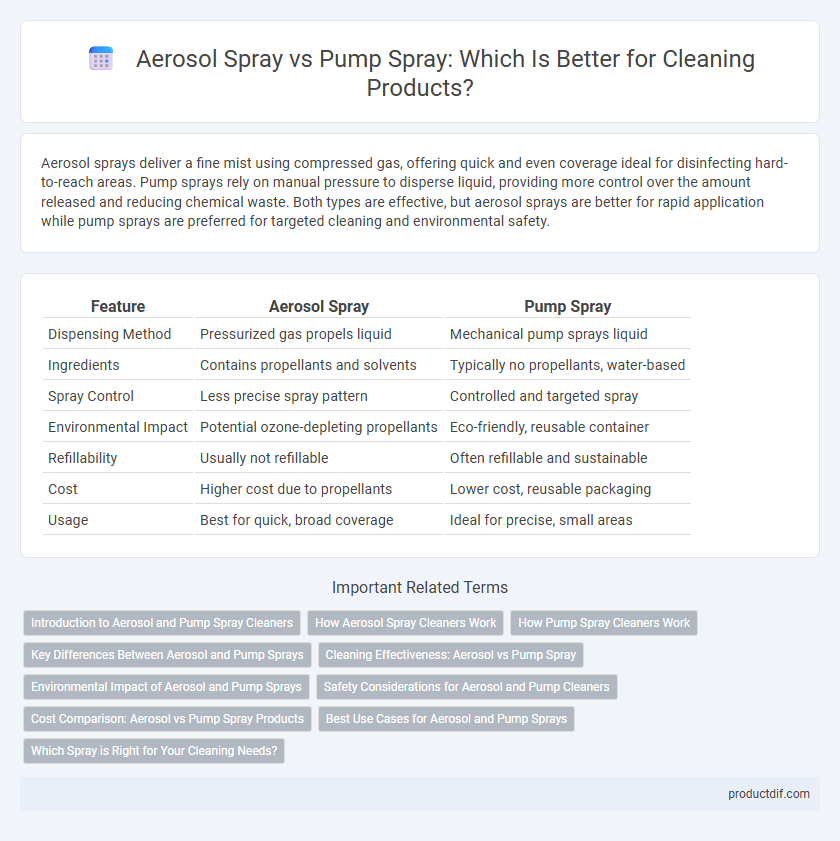Aerosol sprays deliver a fine mist using compressed gas, offering quick and even coverage ideal for disinfecting hard-to-reach areas. Pump sprays rely on manual pressure to disperse liquid, providing more control over the amount released and reducing chemical waste. Both types are effective, but aerosol sprays are better for rapid application while pump sprays are preferred for targeted cleaning and environmental safety.
Table of Comparison
| Feature | Aerosol Spray | Pump Spray |
|---|---|---|
| Dispensing Method | Pressurized gas propels liquid | Mechanical pump sprays liquid |
| Ingredients | Contains propellants and solvents | Typically no propellants, water-based |
| Spray Control | Less precise spray pattern | Controlled and targeted spray |
| Environmental Impact | Potential ozone-depleting propellants | Eco-friendly, reusable container |
| Refillability | Usually not refillable | Often refillable and sustainable |
| Cost | Higher cost due to propellants | Lower cost, reusable packaging |
| Usage | Best for quick, broad coverage | Ideal for precise, small areas |
Introduction to Aerosol and Pump Spray Cleaners
Aerosol spray cleaners use compressed gas to deliver a fine mist, providing even coverage and efficient application on surfaces, especially for hard-to-reach areas. Pump spray cleaners rely on manual pressure to dispense liquid, allowing controlled and targeted use with less environmental impact due to the absence of propellants. Both options offer distinct advantages for household and industrial cleaning tasks, with aerosol sprays favored for rapid disinfection and pump sprays preferred for precision and eco-friendliness.
How Aerosol Spray Cleaners Work
Aerosol spray cleaners use compressed gas to disperse cleaning agents in a fine mist, allowing for even and controlled coverage on surfaces. The propellant inside the can forces the liquid cleaner out through a nozzle when the valve is pressed, producing a consistent spray pattern ideal for cleaning hard-to-reach areas. This pressurized delivery system enhances the effectiveness of solvents and detergents by promoting rapid evaporation and thorough surface contact.
How Pump Spray Cleaners Work
Pump spray cleaners operate using a manual pump mechanism that pressurizes the liquid inside, allowing for controlled, fine mist application without the use of propellants. This method ensures even coverage of cleaning surfaces while reducing chemical waste and environmental impact compared to aerosol sprays. The absence of aerosol propellants makes pump sprays a safer option for indoor use and offers better control over product usage.
Key Differences Between Aerosol and Pump Sprays
Aerosol sprays release cleaning products using compressed gases, allowing fine mist dispersal that covers large areas quickly, while pump sprays rely on manual pressure to deliver a controlled, direct stream. Aerosols tend to be more efficient for even application and reach, but pump sprays offer better environmental safety by eliminating propellants and reducing chemical waste. Choosing between the two depends on the cleaning task, environmental concerns, and product formulation requirements.
Cleaning Effectiveness: Aerosol vs Pump Spray
Aerosol sprays deliver cleaning products in fine, consistent mist particles that enhance surface coverage and penetration into tough grime, improving overall cleaning effectiveness. Pump sprays typically release larger droplets that may result in uneven distribution and less efficient dirt removal on textured surfaces. Choosing aerosol formulas can lead to faster drying times and more thorough cleaning, especially for stubborn stains.
Environmental Impact of Aerosol and Pump Sprays
Aerosol sprays contain propellants such as hydrofluorocarbons (HFCs) that contribute significantly to greenhouse gas emissions and ozone layer depletion, posing substantial environmental risks. Pump sprays eliminate the need for harmful propellants by using manual pressure to dispense product, resulting in a lower carbon footprint and reduced air pollution. Choosing pump sprays over aerosol variants significantly decreases VOC emissions and supports more sustainable cleaning practices.
Safety Considerations for Aerosol and Pump Cleaners
Aerosol sprays often contain flammable propellants and volatile organic compounds, increasing risks of inhalation hazards and fire, requiring use in well-ventilated areas and away from open flames. Pump sprays, typically free from propellants, present fewer respiratory risks and offer greater control over product dispensing but may expose users to surface contaminants if nozzles are not cleaned regularly. Proper storage and handling of both types are essential to minimize accidental exposure and ensure safe cleaning practices.
Cost Comparison: Aerosol vs Pump Spray Products
Aerosol spray products typically involve higher manufacturing and packaging costs due to pressurized canisters and propellants, making them more expensive per unit compared to pump spray products. Pump sprays use simpler mechanisms and standard plastic bottles, resulting in lower production expenses and more affordable retail prices. Consumers often find pump spray products offer better cost efficiency and sustainability over time, especially when purchased in bulk or refillable formats.
Best Use Cases for Aerosol and Pump Sprays
Aerosol sprays deliver fine mist and rapid coverage, making them ideal for disinfecting hard-to-reach surfaces and quickly sanitizing large areas. Pump sprays provide controlled, targeted application with less product waste, perfect for delicate surfaces and precise cleaning tasks. Choosing between aerosol and pump sprays depends on the surface type, desired spray intensity, and area size for optimal cleaning efficiency.
Which Spray is Right for Your Cleaning Needs?
Aerosol sprays deliver a fine mist through pressurized propellants, making them ideal for hard-to-reach areas and fast evaporating cleaning solutions. Pump sprays use manual pressure to dispense liquid, offering greater control over spray intensity and reducing environmental impact by eliminating propellants. Choosing between aerosol and pump sprays depends on your cleaning surface, desired spray coverage, and preference for eco-friendly products.
Aerosol spray vs Pump spray Infographic

 productdif.com
productdif.com